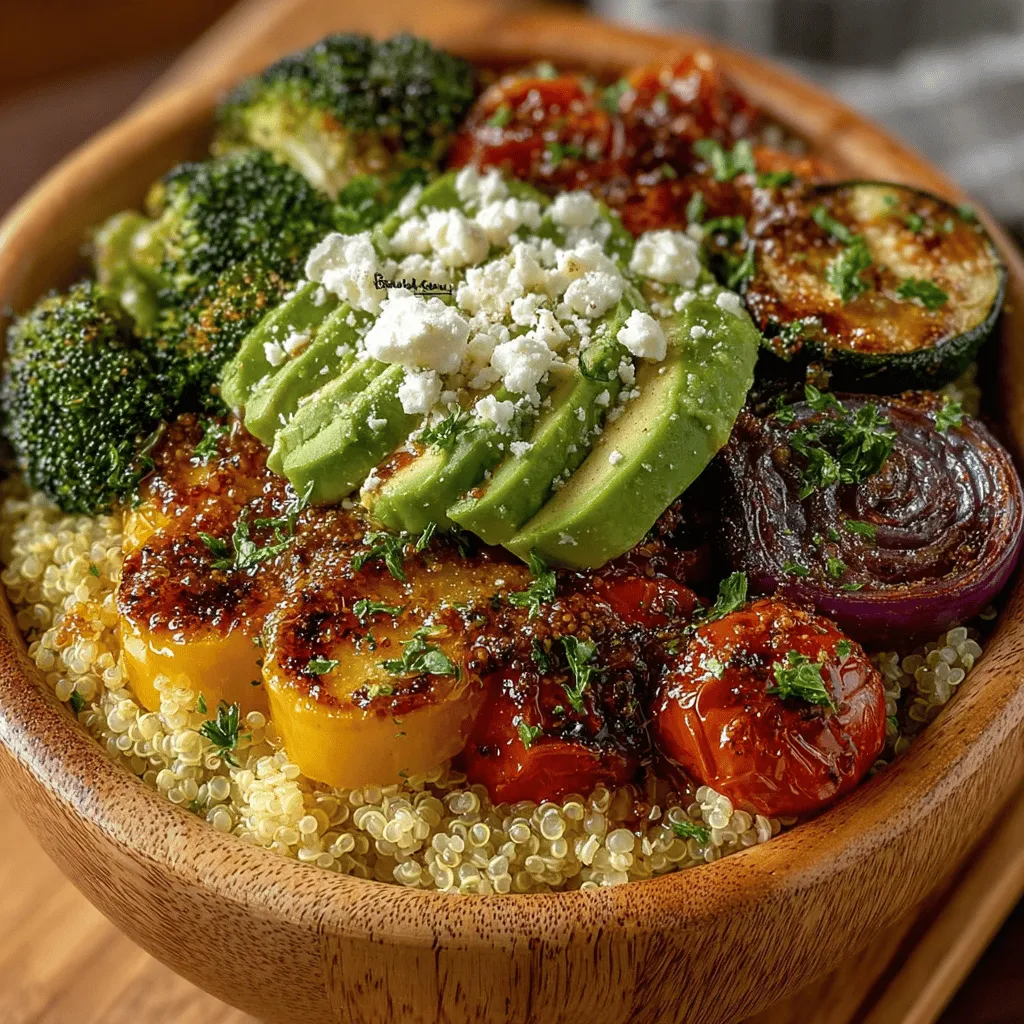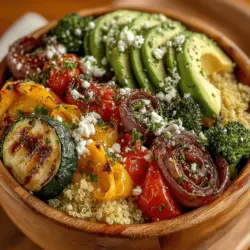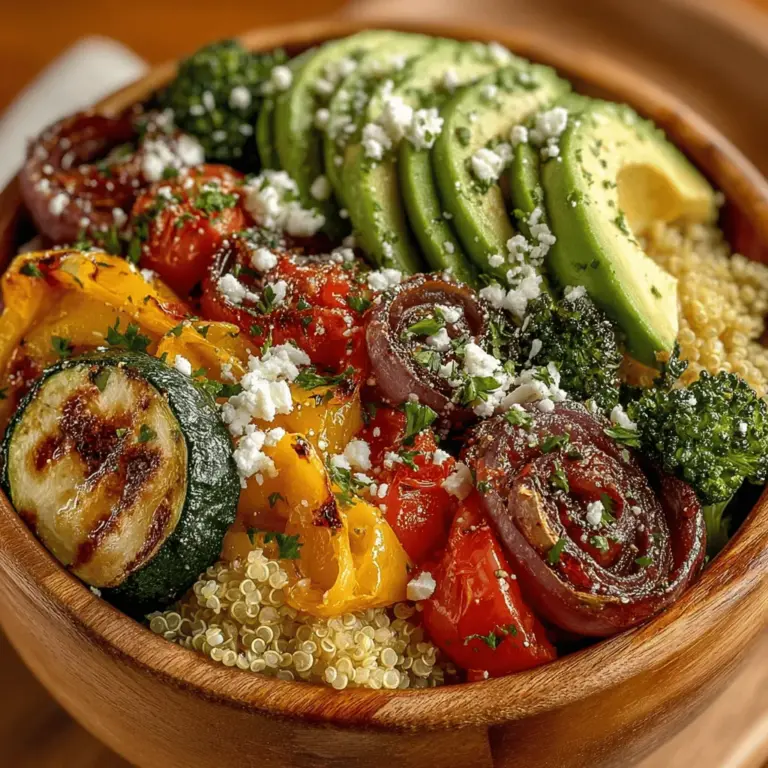Quinoa and Roasted Veggie Power Bowls: A Nutritional Delight
In recent years, plant-based meals have surged in popularity, capturing the attention of health enthusiasts and culinary adventurers alike. This shift towards vegetarian and vegan dining options not only highlights a growing awareness of health and wellness but also emphasizes the environmental benefits of reducing meat consumption. Among the myriad of plant-based dishes available, Quinoa and Roasted Veggie Power Bowls stand out as a vibrant, nutritious, and satisfying choice that caters to a variety of tastes and dietary preferences.
Quinoa, often hailed as a superfood, plays a pivotal role in this recipe, serving as a protein-packed base that complements an array of roasted vegetables. These power bowls are not only colorful and visually appealing but also boast a wealth of nutrients that support a healthy lifestyle. By incorporating a variety of vegetables, you can easily enhance the flavor profile and nutritional value of your meal, making it a perfect option for lunch or dinner.
Understanding Quinoa: The Superfood
Quinoa (Chenopodium quinoa) is a grain-like seed native to South America and has been cultivated for thousands of years. It gained prominence in the culinary world due to its impressive nutritional profile and versatility. Unlike many grains, quinoa is considered a complete protein, which means it contains all nine essential amino acids that the body cannot produce on its own. This makes it an excellent choice for vegetarians and vegans who may struggle to obtain sufficient protein from traditional plant sources.
A 1-cup serving of cooked quinoa provides approximately 8 grams of protein, along with significant amounts of dietary fiber, magnesium, phosphorus, potassium, and various vitamins. It is also gluten-free, making it suitable for those with gluten sensitivities or celiac disease. When comparing quinoa to other grains, such as rice or wheat, quinoa emerges as a superior option due to its higher protein content and broader nutrient spectrum.
Cooking quinoa is straightforward, and it can be prepared using various methods. The most common approach is to rinse the seeds thoroughly before boiling them in water or broth to enhance their flavor. Quinoa typically cooks in about 15 minutes, transforming into a fluffy, nutty base that pairs perfectly with roasted vegetables.
Health Benefits of Roasted Vegetables
Roasting vegetables is a culinary technique that not only enhances their flavor but also preserves their nutritional value. Unlike boiling or steaming, which can lead to nutrient loss, roasting concentrates the natural sugars in vegetables, resulting in a deliciously caramelized outcome that brings out their innate goodness.
Incorporating a diverse array of vegetables into your diet offers numerous health benefits. Vegetables are low in calories yet high in essential vitamins, minerals, and antioxidants. They play a crucial role in preventing chronic diseases, supporting digestion, and boosting overall immunity. Furthermore, different vegetables provide unique health benefits; for instance, leafy greens like spinach and kale are rich in iron and calcium, while bell peppers boast high levels of vitamin C.
When preparing Quinoa and Roasted Veggie Power Bowls, consider seasonal vegetables to maximize flavor and freshness. Spring brings tender asparagus and vibrant radishes, summer showcases zucchini and corn, autumn offers hearty root vegetables like sweet potatoes and carrots, and winter features robust Brussels sprouts and hearty squash. The possibilities are endless, allowing you to tailor your dish to the season and your personal preferences.
Ingredients Breakdown
A well-balanced Quinoa and Roasted Veggie Power Bowl requires a thoughtful selection of ingredients to create a harmonious blend of flavors and textures. Here’s a breakdown of the main components:
1. Quinoa: Choose from various quinoa types, including white, red, and black. White quinoa has a mild flavor and fluffy texture, while red quinoa offers a nuttier taste and chewier consistency. Black quinoa, though less common, adds striking color and a slightly sweet taste. When selecting quinoa, look for organic options to ensure quality.
2. Vegetables: The heart of the power bowl lies in the vegetables. A mix of colors not only enhances visual appeal but also maximizes nutrient variety. Consider options such as bell peppers, zucchini, broccoli, carrots, and cherry tomatoes. Each vegetable brings its unique set of health benefits, so feel free to experiment with your favorites.
3. Olive Oil and Balsamic Vinegar: The combination of high-quality olive oil and balsamic vinegar is essential for flavor enhancement. Olive oil provides healthy monounsaturated fats, while balsamic vinegar adds a tangy sweetness that complements the roasted vegetables beautifully.
4. Optional Toppings: To elevate your power bowl, consider adding toppings such as crumbled feta cheese for a creamy contrast or plant-based alternatives for a vegan-friendly option. Nuts and seeds can also provide a satisfying crunch, while fresh herbs like parsley or cilantro can add an aromatic touch.
Preparation Steps in Detail
Now that you have an understanding of the recipe components, let’s delve into the initial preparation steps to create your Quinoa and Roasted Veggie Power Bowls.
1. Preheat the Oven: Start by preheating your oven to 425°F (220°C). A hot oven is essential for achieving perfectly roasted vegetables with a caramelized exterior.
2. Prepare the Quinoa: Rinse 1 cup of quinoa under cold water to remove any bitterness. In a saucepan, combine the rinsed quinoa with 2 cups of vegetable broth or water. Bring to a boil, then reduce the heat to a simmer, cover, and cook for about 15 minutes, or until all the liquid is absorbed. Once cooked, fluff the quinoa with a fork and set aside.
3. Chop the Vegetables: While the quinoa is cooking, wash and chop your selection of vegetables into bite-sized pieces. Aim for uniformity in size for even roasting. Spread the chopped vegetables on a baking sheet lined with parchment paper for easy cleanup.
4. Toss with Olive Oil and Seasonings: Drizzle the chopped vegetables with olive oil and sprinkle with salt, pepper, and any additional herbs or spices you desire (such as garlic powder or Italian seasoning). Toss the vegetables until they are evenly coated in the oil and seasonings.
5. Roast the Vegetables: Transfer the baking sheet to the preheated oven and roast the vegetables for 20-25 minutes. Stir them halfway through to ensure even cooking. They should be tender and slightly caramelized when done.
As you progress through these initial steps, the enticing aroma of roasting vegetables will fill your kitchen, setting the stage for a delicious and nourishing meal. The combination of quinoa and roasted veggies not only satisfies your hunger but also provides a delightful array of flavors and textures, making every bite a celebration of wholesome ingredients. Whether you are preparing this dish for yourself or sharing it with friends and family, Quinoa and Roasted Veggie Power Bowls are sure to impress and nourish.

Preheating the Oven: Importance for Even Cooking
Before diving into the recipe, preheating your oven is a crucial first step. This ensures that the vegetables roast evenly, achieving that perfect golden-brown exterior while retaining their natural flavors and nutrients. Set your oven to 425°F (220°C) and allow it to heat up fully before placing your vegetables inside. This not only promotes even cooking but also enhances the caramelization process, resulting in a delightful depth of flavor.
Preparing Quinoa: Detailed Rinsing and Cooking Instructions
Quinoa is a fantastic base for your power bowls, loaded with protein and fiber. Properly preparing quinoa is essential for achieving the best texture and flavor. Start by measuring out 1 cup of quinoa and rinsing it under cold running water. This step removes the natural coating called saponin, which can impart a bitter taste.
After rinsing, place the quinoa in a medium saucepan and add 2 cups of water or vegetable broth for added flavor. Bring the mixture to a boil over medium-high heat. Once boiling, reduce the heat to low, cover the saucepan, and let it simmer for about 15 minutes. You’ll know it’s done when the quinoa has absorbed all the liquid and the grains are fluffy, with a slight germ ring visible around each seed. Remove from heat and let it sit, covered, for an additional 5 minutes before fluffing it with a fork.
Roasting Vegetables: Step-by-Step Guide to Seasoning and Roasting
The star of the show is undoubtedly the roasted vegetables, which contribute a burst of color and flavor to your bowls. You can use any combination of vegetables you enjoy; popular choices include bell peppers, zucchini, carrots, and red onions. Here’s how to prepare them:
1. Chop the Vegetables: Cut your chosen vegetables into bite-sized pieces to ensure even roasting. Aim for uniform sizes to promote consistent cooking.
2. Seasoning: In a large mixing bowl, combine the chopped vegetables with 2 tablespoons of olive oil, 1 teaspoon of garlic powder, and 1 teaspoon of smoked paprika. Toss well to coat all the pieces evenly. You can also add salt and pepper to taste.
3. Arranging on a Baking Sheet: Spread the seasoned vegetables in a single layer on a baking sheet lined with parchment paper. This prevents sticking and makes cleanup easier.
4. Roasting: Place the baking sheet in the preheated oven and roast for about 20-25 minutes. Halfway through, stir the vegetables to ensure they roast evenly. They should be tender and caramelized when done.
Timing and Temperature Considerations for Optimal Results
The key to perfectly roasted vegetables lies in timing and temperature. Roasting at 425°F (220°C) allows the vegetables to caramelize beautifully without becoming mushy. Keep an eye on them as they roast; you want them to be fork-tender with a slight char but not overly darkened. Adjust the roasting time based on the types of vegetables you’re using; denser vegetables like carrots may need a bit longer than softer ones like zucchini.
Assembling the Bowls: Tips for Presentation and Portioning
Once the quinoa and vegetables are ready, it’s time to assemble your power bowls. Start with a base of quinoa—about ½ cup per serving is a good portion. Next, top with a generous amount of roasted vegetables, arranging them artistically for a visually appealing presentation.
For added nutrition and flavor, consider adding a handful of fresh greens such as spinach or arugula. You can also sprinkle on some nuts or seeds (like sunflower seeds or sliced almonds) for crunch, and a drizzle of balsamic vinegar or tahini to elevate the taste. Remember, the goal is to create a colorful and inviting bowl that’s as pleasing to the eye as it is to the palate.
Flavor Profile and Variations
Exploring the Taste Combinations of Garlic Powder, Smoked Paprika, and Balsamic Vinegar
The combination of garlic powder and smoked paprika brings a warm, savory flavor to the roasted vegetables, while balsamic vinegar adds a tangy sweetness that balances the dish perfectly. This trio enhances the overall profile, making each bite a flavorful experience.
Suggestions for Additional Spices and Herbs to Customize Flavors
Feel free to get creative with additional spices and herbs. Consider adding cumin or coriander for a warming spice blend, or fresh herbs like thyme, rosemary, or basil for a touch of freshness. A sprinkle of red pepper flakes can add a delightful kick if you enjoy a bit of heat.
Seasonal Variations: Adapting the Recipe with Seasonal Vegetables
One of the beauties of power bowls is their versatility. You can easily adapt this recipe by incorporating seasonal vegetables. In the spring, try asparagus and peas; in the summer, use corn and cherry tomatoes; in the fall, consider roasted sweet potatoes and Brussels sprouts. The ability to change ingredients based on availability ensures that your bowls are always fresh and exciting.
Serving Suggestions
Ideas for Serving the Bowls: Plating and Garnishing for Visual Appeal
To make your power bowls even more appetizing, consider the presentation. Use deep bowls to create layers of color and texture. Garnish with fresh herbs like cilantro or parsley for a pop of color. A slice of lemon or lime on the side can also add a refreshing touch when serving.
Pairing Suggestions: Complementary Dishes and Beverages
These quinoa and roasted veggie power bowls pair wonderfully with a side of crusty whole-grain bread or a light soup, such as a tomato basil bisque. For beverages, consider serving with refreshing iced herbal tea or a light white wine like Sauvignon Blanc for a perfect balance.
Meal Prep Versatility: How to Store Leftovers and Reheat
The beauty of this recipe lies in its meal prep potential. You can store leftover quinoa and roasted vegetables in airtight containers in the refrigerator for up to 4 days. When reheating, simply warm the quinoa and vegetables in the microwave or on the stovetop until heated through. This makes for a quick and healthy lunch option throughout the week.
Nutritional Information
Breakdown of Calories, Macronutrients, and Micronutrients per Serving
Each serving of these quinoa and roasted veggie power bowls is not only delicious but also packed with nutrients. A typical serving contains approximately:
– Calories: 350-400
– Protein: 12-15g
– Carbohydrates: 60-65g
– Fat: 10-15g
– Fiber: 8-10g
Additionally, this dish is rich in vitamins and minerals, including vitamin A from the carrots, vitamin C from bell peppers, and iron from quinoa.
Discussion on the Health Impacts of Balanced Meals
Including a variety of vegetables and whole grains in your diet is crucial for maintaining overall health. The fiber content aids in digestion, while the protein from quinoa supports muscle repair and growth. This balanced meal is not only nourishing but also satisfying, making it a great choice for anyone looking to improve their diet.
Conclusion
In summary, quinoa and roasted veggie power bowls are not only a feast for the eyes but also a wholesome choice for your body. They offer a delightful combination of flavors, textures, and nutritional benefits. Incorporating plant-based meals like this into your diet is a fantastic way to enhance your health and wellbeing.
I encourage you to experiment with different vegetables, spices, and toppings to create your unique version of these power bowls. Each variation can bring a new twist, making mealtime exciting and satisfying. Enjoy your culinary journey and the nourishing goodness of these vibrant bowls!


